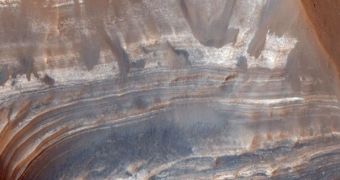Pieces of evidence that the Red Planet was at one point partially covered in water are now beginning to mount considerably. Nearly all new scientific pictures sent back by instruments around or on Mars show signs of erosion, or other types of water-related geological degradation. Recently, Planetary Science Institute senior scientist Catherine Weitz published new research conclusions, showing a number of processes that couldn't have taken place on Mars without the presence of water. The findings are added to previous works, which showed that the northern Martian hemisphere might have had an ocean in the past.
Using data collected from three Mars Reconnaissance Orbiter (MRO) scientific instruments, the expert and her team were able to infer the existence of light-toned deposits (LTD) inside the troughs of western Valles Marineris' Noctis Labyrinthus region. Information on these structures was collected from the High Resolution Imaging Science Experiment (HiRISE) camera, the Context Camera (CTX), as well as from the Compact Reconnaissance Imaging Spectrometer for Mars (CRISM), Space Fellowship reports. The team has just finished piecing the puzzle together.
“We analyzed ten troughs containing well-exposed LTD, and we found a lot of variability that we didn’t expect to see. We found that each of the troughs with LTD has a unique mineralogy, and, therefore, the processes occurring in each trough were very localized,” she explained today in San Francisco, at the annual meeting of the American Geophysical Union Conference. In addition, she revealed, a host of clays, hydrated silicas, and sulfate varieties were discovered at each of the analyzed locations. These data also point at different formation processes for each trough.
“Clearly, these areas were affected by water. In some cases there had to be multiple events. But we don’t know how much water was involved or whether it was always a flowing liquid. It might have been groundwater coming from Tharsis, the large volcanic complex to the west. There could have been active volcanism that produced water by melting snow, ice, or underground, hydrothermal processes. These little basins could then have filled or partially filled with some of that water. Another possibility is that material was already in several of the troughs, perhaps as volcanic ash or lava flows, and some kind of hydrothermal activity may have altered these pre-existing deposits,” the expert concluded.

 14 DAY TRIAL //
14 DAY TRIAL //